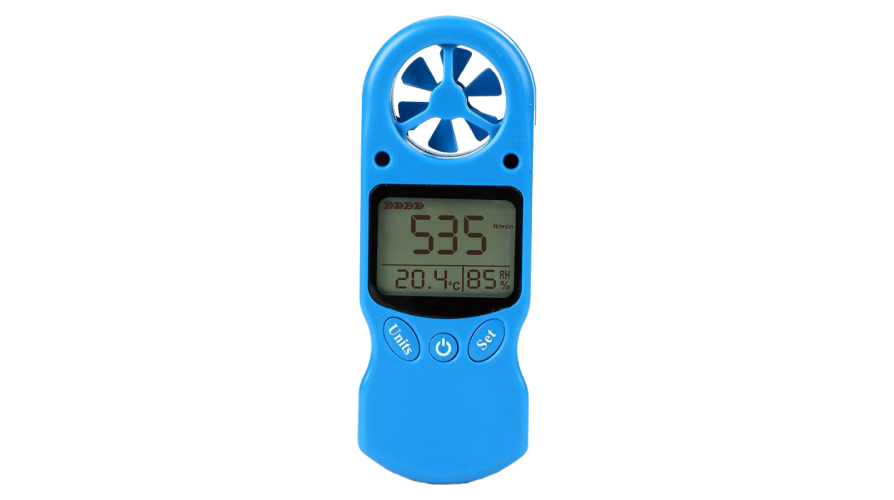Choosing the Right Anemometer: A Comprehensive Buying Guide
Choosing the Right Anemometer: A Comprehensive Buying Guide
Blog Article
All You Need to Learn About Anemometers: How They Function, Why They Issue, and Where to Use Them
Anemometers, however frequently forgotten in the world of scientific instruments, play a critical role in numerous areas, providing useful understandings right into wind speed and air flow patterns. As we delve into the intricacies of anemometer technology, we will certainly reveal the inner workings of these gadgets, their significance, and the essential factors to consider when picking the ideal anemometer for specific applications.

Anemometer Essentials
An essential tool made use of to gauge wind rate and instructions, the anemometer plays a crucial role in weather forecasting and numerous sectors. An anemometer generally includes three or four mugs that rotate in the wind, a vane that aims into the wind, and sensing units to track the motions or rotations. By calculating the turnings or activities over a particular amount of time, the anemometer can determine wind rate. The vane aids establish wind direction by directing into the wind, providing important data for weather condition projecting, air travel, maritime procedures, environmental monitoring, and wind energy applications.
There are various types of anemometers readily available, including cup anemometers, vane anemometers, hot-wire anemometers, and sonic anemometers, each with its one-of-a-kind features and applications. Cup anemometers are generally used for fundamental wind rate measurements, while vane anemometers are liked for directional dimensions.
Concepts of Anemometer Operation
Structure on the fundamental understanding of anemometer basics, the principles of anemometer operation illuminate the mechanics behind wind rate and direction measurements. Anemometers operate on the principle of air flow influencing a sensing unit, causing it to turn. Mug anemometers, for circumstances, have three or more mugs that record the wind, creating them to rotate quicker as the wind rate increases. The rotation rate is then transformed into a wind speed measurement. Vane anemometers, on the other hand, utilize a tail or a probe that straightens itself with the wind direction, offering a measurement of wind direction based on the positioning of the sensor. Hot-wire anemometers depend on a heated wire that cools as wind passes over it, with the price of cooling identifying the wind speed. Ultrasonic anemometers procedure wind rate and instructions by assessing the moment it considers ultrasonic signals to travel between transducers. Recognizing these principles is critical for reliable and precise wind measurements in various applications.
Significance of Anemometers
The importance of anemometers in meteorology and numerous markets can not be overstated. Anemometers play a critical duty in determining this wind rate and direction, supplying important data for climate forecasting, climate studies, ecological surveillance, and aviation procedures. Meteorologists depend on anemometers to gather exact wind data, helping them comprehend weather patterns, forecast tornados, and problem prompt warnings to the general public. In markets such as building and construction, agriculture, eco-friendly energy, and maritime procedures, anemometers are utilized to maximize processes, guarantee safety and security, and boost effectiveness. Wind ranch drivers use anemometers to evaluate wind conditions and optimize power production from wind turbines. In the maritime market, anemometers help ship navigation by offering real-time wind info to captains, helping them make educated choices to make sure secure voyages. In general, anemometers are important devices that contribute dramatically to safety, effectiveness, and informed decision-making in meteorology and a large range of sectors.
Applications Across Various Industries
In the eco-friendly power sector, anemometers play a critical role in evaluating wind conditions for wind ranch placements, making sure optimum power manufacturing. Industries like building and construction and mining make use of anemometers to check wind speeds, vital for safety methods, specifically when functioning at elevations or in open-pit mines where solid winds can posture threats. In farming, anemometers help farmers in taking care of plant spraying by providing real-time information on wind speed to stay clear of drift.

Choosing the Right Anemometer for Your Requirements
For general functions, a cup anemometer is suitable for determining wind speed, while a vane anemometer provides wind direction information. Hot-wire anemometers are ideal for reduced airspeed dimensions, and ultrasonic anemometers provide high precision and toughness.

Final Thought
In conclusion, anemometers play a crucial function in gauging wind rate and instructions throughout numerous sectors. It is important to consider the importance of anemometers in order to make informed decisions when selecting the most appropriate tool for measuring wind conditions.
There are numerous kinds of anemometers offered, consisting of mug anemometers, vane anemometers, hot-wire anemometers, and sonic anemometers, each with its distinct functions and applications. Mug anemometers are commonly utilized for fundamental wind rate dimensions, while vane anemometers are preferred for directional dimensions. Hot-wire anemometers are appropriate for low airspeeds, and sonic anemometers are ideal for high-precision measurements in research study and industrial settings.Building on the foundational understanding of anemometer fundamentals, the principles of anemometer operation clarify the technicians behind wind rate review and instructions dimensions. For basic functions, a mug anemometer is suitable for measuring wind speed, while a vane anemometer gives wind direction information.
Report this page